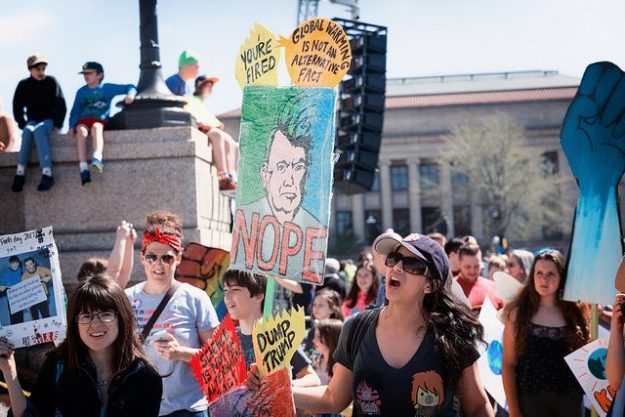
Many thought it couldn’t work: calling scientists out of their libraries and laboratories and into the streets to protest the potential dismantling of institutions supporting advancement of the sciences as regards critical public issues. Tens of thousands hit the streets. In Chicago, there were 40,000 participants, with more four- and five-digit totals reached in D.C., Boston, and elsewhere around the country. In fact, marches for science took place in approximately 610 locales around the globe—across Europe and Asia, and in New Zealand and Australia. Scientists and fans of science marched together, calling for the recognition of the central importance of science to society.
The March for Science was billed as a nonpartisan effort because participants did not want science portrayed as a “liberal endeavor.” Both sides of the aisle should support scientific inquiry and practice, since the data it gathers and analyzes makes up the evidence that supports good policy. Of course, since the marches coincided with Earth Day, the connection of the event to anthropogenic climate change denial was stronger and more solid than it otherwise would have been. Current threats to science funding and national infrastructure have much to do with conservative decrying of the nature and realities of climate change. This has led to proposed deep cuts in the Trump “blueprint” budget for agencies like the National Institutes of Health (NIH) and the Environmental Protection Agency (EPA), where the administration proposed a 31 percent budget cut and a 25 percent cut to the agency’s 15,000 employees. Prior to his election, President Trump made multiple tweets calling climate change and global warming “a hoax.”
This isn’t the first time the scientific community has gotten organized around recent policies. Readers will recall that the temporary travel ban from seven (later six) Muslim-majority countries sparked the overnight development of a network to provide housing and laboratory space to scientists whose travel to the States was banned—sometimes mid-journey. When a conference that was to have explored the public health concerns of climate change was precipitously cancelled by the CDC as Trump took office, activists from the National Park Service protested an imposed shutdown of communication by establishing an alternate twitter account to do public education on climate change. It all reflects a growing sense of activism in the scientific community.
Nor is this the first time that science and politics have come into conflict. The Boston Globe reports senior MIT scientist Richard Petrasso, who studies inertial confinement fusion, came to the rally with a sign reading “March √16 Science.” He commented, “In a sense, Trump is like Pope Urban VIII, who denied to Galileo that the earth goes around the sun.”
The Atlantic reports that many participants understand that the march is not a stand-alone event. It describes Seun Ajiboye, a science policy analyst who had come over from Alexandria, Virginia, as saying about the robustness of the support:
Sign up for our free newsletters
Subscribe to NPQ's newsletters to have our top stories delivered directly to your inbox.
By signing up, you agree to our privacy policy and terms of use, and to receive messages from NPQ and our partners.
“This grassroots support speaks to policy-makers that their constituents are interested in science. It’s a physical and dramatic show of support.” She is also aware of many post-march efforts to mobilize people into taking steps that will establish political power, like visiting their representatives. “The March is just the starting point for engaging a lot of people.”
As with the women’s march, issues of diversity and inclusion arose early, during the organizing of the march. This dialogue, too, will likely carry forward as the movement gets clearer about its long-term purposes. As reported in the New York Times:
Ayana Elizabeth Johnson, a marine biologist and the march’s co-director of partnerships and a member of its diversity team, said diversity and inclusion have been core parts of the march since its beginning, but the group has had several brutally honest conversations to make sure their messaging aligned with their values. The public conversations surrounding the march, she said, are an important step toward addressing discrimination problems within science.
“It’s shining a light on the scientific community, airing its dirty laundry in a way,” said Dr. Johnson. “But I think that’s a really valuable step in figuring out how we can do better as a community.”













